Tampa Bay
By Associated Press
AP Photo/Mosa’ab Elshamy
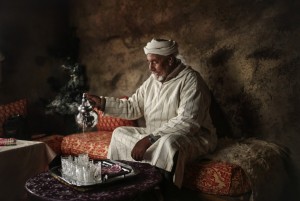
IMILCHIL, Morocco — Deep in Morocco’s Atlas Mountains, the ancient Berbers live on, defying a harsh environment and loyal to their traditions and way of life in some of the most hard-to-reach parts of the African continent.
Indomitable and proud, they call themselves the Amazigh, which is believed to mean “free people” or “noble men,” and trace their origins as an indigenous people in western North Africa to at least 10,000 B.C.
They dislike the term Berbers, which stems from Latin and which they find insulting. They are among the many peoples the Romans called Barbarians but they became the stuff of legends, giving the world famous names such as the medieval explorer Ibn Battuta, who travelled further in distance than Marco Polo.
Their home is the majestic Atlas, the largest mountain range in Africa. Amazigh villages are scattered across arid desert landscapes with burnt-orange rock, occasionally dotted with lush green slopes and surrounded by snow-capped peaks.
Across North Africa, the Berbers number about 50 million. At least 15 million Moroccans are Amazigh, divided into different groups according to their dialects. While they speak the native Amazigh language of Tamazight, which has a large number of dialects and recently gained recognition as an official language in Morocco, many have adopted Arabic as part of a long process of Arabization and Islamization.
Today they rely on cattle and agriculture as their main sources of income and maintain a nomadic lifestyle closely resembling that of their ancestors. Some live in clay houses with no electricity or running water while a few still dwell with their sheep and goats in remote mountain caves. Others live closer to the towns at the Atlas foothills, benefiting from modern amenities.
For much of the year, they face extreme weather conditions. The mountains are covered in snow in winter, and in summer, the sun scorches what little crops they grow. When the streams empty out during the dry season, the community bands together to dig underground water wells for irrigation.
Many Amazigh own mountain donkeys, often the only mode of transport across the rocky, unpaved roads that connect Berber villages.
That isolation has dashed 26-year-old Mohammed Tamejout’s hopes of finding a job away from home. He studied geography at the university in the Atlas city of Ouarzazate, expecting the degree would lead to a job. But three years after graduating, he remains unemployed and works on his family’s farm in Imilchil, surrounded by almond trees.
When the trees bloom, the farm becomes a sea of cotton-white almond blossoms amid green pastures. Mohammed says the idyllic scene doesn’t touch him.
“There’s no future for me here. If I don’t move to the city, I’ll remain a farmer for the rest of my life,” he said.
Here is a series of images by AP photographer Mosa’ab Elshamy of the Amazigh in the Atlas Mountains.
In this Friday, Feb. 5, 2016 photo (above), Hajj Saeed, 56, an Amazigh villager, pours tea for guests at his home in the Middle Atlas town of Tounfit, near the province of Midelt, central Morocco. Across North Africa, the Berbers number about 50 million. At least 15 million Moroccans are Amazigh, divided into different groups according to their dialects. While they speak the native Amazigh language of Tamazight, which has a large number of dialects and recently gained recognition as an official language in Morocco, many have adopted Arabic as part of a long process of Arabization and Islamization.
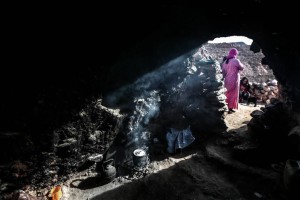
In this Thursday, Feb. 4, 2016 photo, Aesha, 45, stands outside her cave where she lives with her family, in the desert of the Anti-Atlas mountains, east of Ourazazate, Morocco. Amazigh villages are scattered across arid desert landscapes with burnt-orange rock, occasionally dotted with lush green slopes and surrounded by snow-capped peaks. Some live in clay houses with no electricity or running water while a few still dwell with their sheep and goats in remote mountain caves. Others live closer to the towns at the Atlas foothills, benefiting from modern amenities.
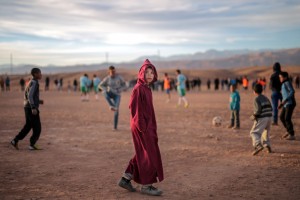
In this Wednesday, Feb. 3, 2016 photo, an Amazigh boy pauses to look at the camera during a locally-organized football tournament between different tribes, in Kelaat M’Gouna town, southern Morocco. Across North Africa, the Berbers number about 50 million.
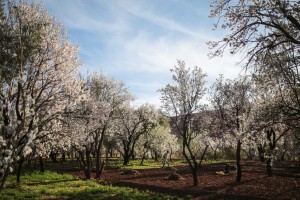
In this Tuesday, Feb. 2, 2016 photo, Amazigh villager Mohammed Tamejout, 26, works in his farm between almond blossoms, in the town of Kasbah Ellouze, near Kalaat M’Gouna, Morocco. Indomitable and proud, they call themselves the Amazigh, which is believed to mean “free people” or “noble men,” and trace their origins as an indigenous people in western North Africa to at least 10,000 B.C.
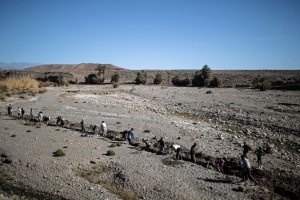
In this Tuesday, Feb. 2, 2016 photo, Amazigh villagers dig a canal in search for underground water to irrigate their crops, in the village of Douar Timneit, next to Ouarzazate, central Morocco. The Amazigh dislike the term Berbers, which stems from Latin and which they find insulting. They are among the many peoples the Romans called Barbarians but they became the stuff of legends, giving the world famous names such as the medieval explorer Ibn Battuta, who travelled further in distance than Marco Polo.
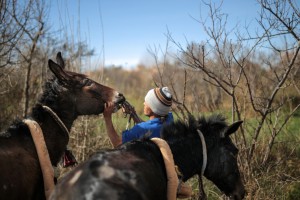
In this Wednesday, Feb. 3, 2016 photo, Yusuf ait Mohammed, 30, fits a bridle to his horse, before ploughing his land, in a village next to Kalaat M’Gouna, in Ouarzazate, Morocco. Today the Amazigh rely on cattle and agriculture as their main sources of income and maintain a nomadic lifestyle closely resembling that of their ancestors. Some live in clay houses with no electricity or running water while a few still dwell with their sheep and goats in remote mountain caves. Others live closer to the towns at the Atlas foothills, benefiting from modern amenities.
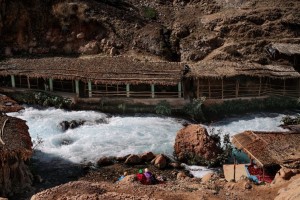
In this Saturday, Feb. 6, 2016 photo, Amazigh women wash laundry by the Oum Rabia water springs, in KhÃnifra, Morocco.
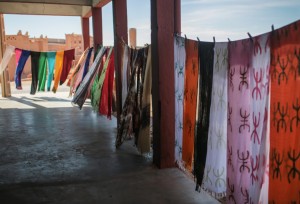
In this Wednesday, Feb. 3, 2016 photo, scarves with the Amazigh symbol are displayed outside a tourist shop, in Kalaat M’Gouna, in Ouarzazate, Morocco.
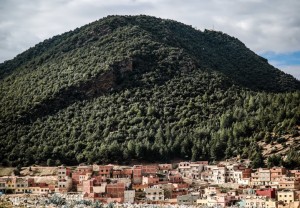
In this Saturday, Feb. 6, 2016 photo, Amazigh houses sit in the foothills of Cedar trees forests, in Azrou, a town south of Fez. Deep in Morocco’s Atlas Mountains, the ancient Berbers live on, defying a harsh environment and loyal to their traditions and way of life in some of the most hard-to-reach parts of the African continent.
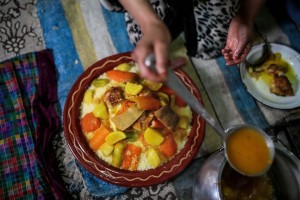
In this Friday, Feb. 5, 2016 photo, Fatima, 36, prepares a meal of Couscous, a traditionally Amazigh dish, at her home in a town near Tounfit in the Middle Atlas, central Morocco. Today the Amazigh rely on cattle and agriculture as their main sources of income and maintain a nomadic lifestyle closely resembling that of their ancestors. Some live in clay houses with no electricity or running water while a few still dwell with their sheep and goats in remote mountain caves. Others live closer to the towns at the Atlas foothills, benefiting from modern amenities.
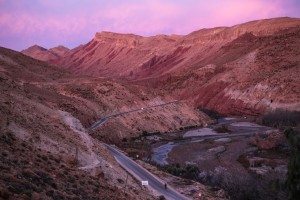
This Wednesday, Feb. 3, 2016 photo shows, a view of the Anti-Atlas mountains town of Boutaghrar after sunrise, east of Ourazazate, Morocco.
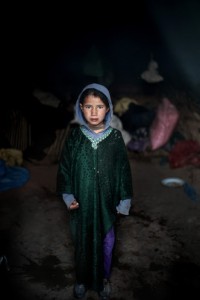
In this Thursday, Feb. 4, 2016 photo, Fatima, 5, poses for a picture inside a cave where she lives with her family, in the desert of the Anti-Atlas mountains, east of Ourazazate, Morocco.







